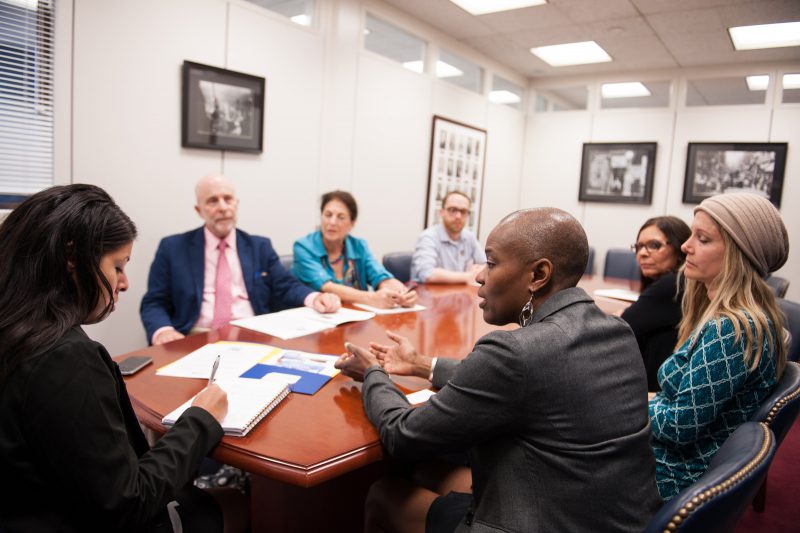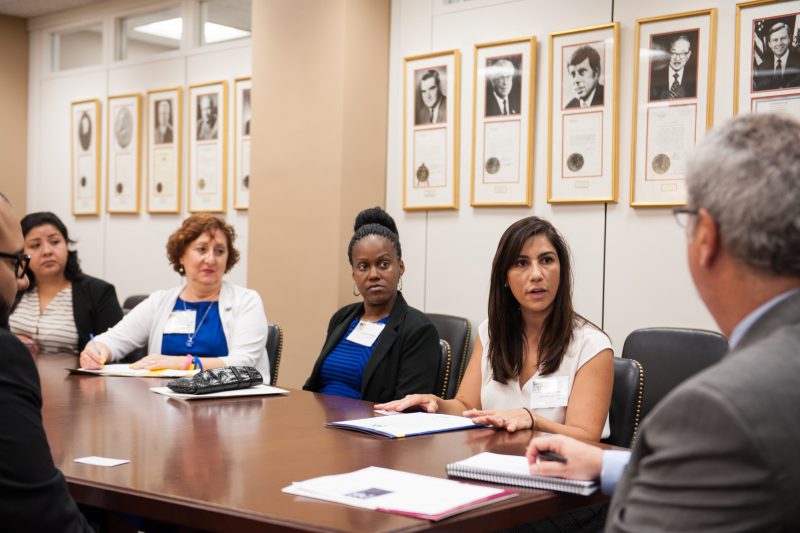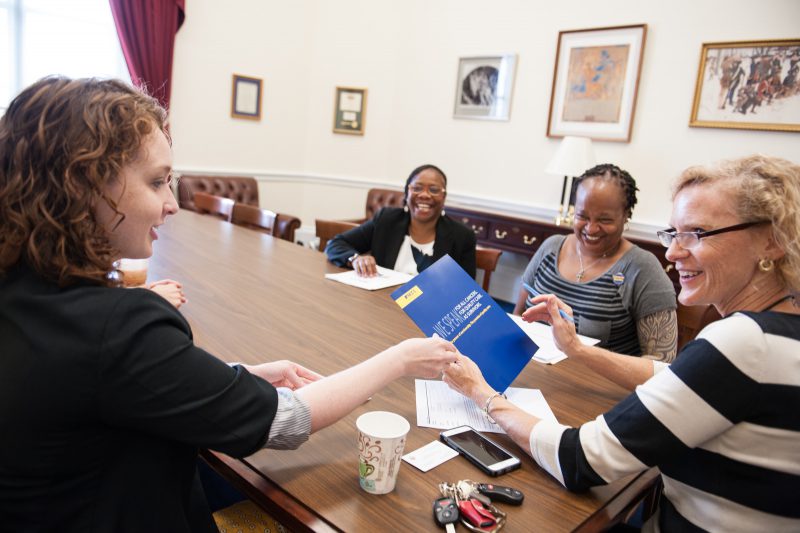Your generous year-end donation will be matched $1 for $1 DONATE
CCPCA Toolkit for Congressional Visits
CCPCA: How To Visit Congressional District Offices

NCCS CPAT Members from New York meet with Sen. Chuck Schumer’s office.
Advocating for legislation doesn’t only happen in Washington, DC, but back home in the district as well, especially during district work days when Congress is not in session.
All senators and representatives in Congress have offices in their state or home district where constituents can meet with their representatives. Many Members of Congress also often host local events like town halls or coffee conversations. These are excellent opportunities to speak with the Member or their staff about why H.R. 5183, the CCPCA is so important.
Below, you’ll find a step-by-step guide and a webinar about how to advocate for CCPCA with your Members of Congress.
Step-by-Step Guide for District Meetings
NOTE: Due to COVID-19, many Congressional staff members continue to work remotely. Your best bet for scheduling a meeting may be to request a virtual meeting.
Step 1: Legislative Schedule and Finding Your Members
- Senate
- To find who your senators are, go to www.senate.gov
- To see when the Senate has a state work period, visit https://www.senate.gov/legislative/2023_schedule.htm.
- House of Representatives
- To find who your representative is, go to https://www.house.gov/representatives/find-your-representative.
- To see when the House has a district work period, visit https://www.congress.gov/calendars-and-schedules.
- The websites above will link to your legislator’s individual websites, where you can find their office locations and phone numbers, usually under the “Contact” tab.
- Note: You can learn more about your senators and representative from their websites, especially by reading their biographies and by reviewing committee assignments.
Step 2: Scheduling Your District Meetings
- Familiarize yourself with CCPCA: CCPCA Advocacy Slide Deck PDF
- Call the district office most convenient to you and explain that you are a constituent who would like to speak to your senator/representative about H.R. 5183, the Cancer Care Planning and Communications Act, while he/she is in the district for work days.*
- You may be referred to your legislator’s Washington, DC office, as they often handle legislative issues. If so, politely say you’d prefer to meet with someone in person and can’t travel to Washington, and ask what opportunities are available locally.
- You will likely be given an appointment with a staffer.
- If your representative has already cosponsored CCPCA, it is not necessary to request a meeting with him/her. Check the list of cosponsors on congress.gov.
*Note: If you need help scheduling your meeting or would like NCCS to schedule it for you, please email cpat@canceradvocacy.org.
Step 3: Conducting the Meeting
Make the Pitch
 Make brief introductions: your name, city, connection to cancer, and that you are an NCCS advocate.
Make brief introductions: your name, city, connection to cancer, and that you are an NCCS advocate.- Note that the purpose of the meeting is for you to talk about the bipartisan CCPCA.
- Briefly explain CCPCA by using the leave-behind material (below), especially the fact sheet.
- Give a compelling but precise and brief story of why CCPCA should become law.
- If possible, explain how your personal experience shows that coordinated care planning as allowed under CCPCA must be standard practice. If you need help turning your story into an effective “pitch,” use our “Telling Your Story” worksheet.
Talking Points, Questions That May Arise
- Share your personal experience (or that of a loved one). “In my personal experience, it was difficult to navigate through diagnosis, treatment, and then transition to survivorship care, and I’ve heard the same from so many of my fellow cancer survivors.”
- Highlight the need for care planning adoption outside of cancer centers. “Right now, only some patients treated at larger cancer centers receive care plans. All Medicare beneficiaries deserve this regardless of where they are treated, and this legislation would help make that happen. Furthermore, it would be a first step to help the rest of the health care system adopt this approach so ALL cancer patients receive this cancer care communication and planning support.”
- Cost of the bill, if asked: “We cannot give you an exact cost because the bill has not been scored by the Congressional Budget Office, but it is not likely to be a significant expenditure. Also, the shared decision-making components of the bill may reduce treatment that cancer survivors do not want.”
- **If they ask any questions that you cannot answer, say truthfully that you cannot answer but that you will ask someone from NCCS to follow up with their office with an answer. Let NCCS know of the need to follow up with the office when completing your Congressional Report Form (see Step 4).
Make the Ask
- In the House: “Will you please cosponsor H.R. 5183, the CCPCA?”
- In the Senate: “Will you please introduce companion legislation to H.R. 5183, the CCPCA?”
 Leave-Behind Material
Leave-Behind Material
- Leave-behind materials provide additional information to help support your request of your Member of Congress.
- There is one document you should take to your meeting and give to the staffer you meet with:
**If you have any questions at all about district meetings, town halls, or would like to practice a session, please don’t hesitate to contact us at cpat@canceradvocacy.org.
Step 4: After-Meeting Thank You and Followup
Send a Thank You Note via Email After Your Meetings
- Please write a thank you email to every person you met with—each staffer and Member of Congress.
- Include the key points:
- Thank you for meeting with me to discuss CCPCA, we hope that you will cosponsor (in the House)/introduce (in the Senate) this legislation that is so important to cancer survivors.
- Add your mailing address at the end of the email so that the office knows you are a constituent.
Inform NCCS About Your Visit
- Please complete our Congressional Visit Report form for each meeting you have.
- If more than one person attended the meeting, more than one report is fine but not necessary.
- Please note in one of your responses where your meeting occurred (i.e. district office, town hall, etc)
- Note: If you met with your House representative, you only need to answer questions 1-7. If you met with your senator, you only need to answer questions 1, 2, and 8-12.
Step 5: Social Media and Your District Visit
Promote Your District Visit on Social Media
- Facebook: Post the photo on your Facebook timeline with a caption such as “Meeting with Representative Smith to talk about #CCPCA and why #CancerCarePlanning means so much to cancer survivors.” Be sure to tag NCCS’s Facebook page (type “@cancersurvivorship” and choose our page).
- Twitter: Tweet your photos and note that you just asked your Member of Congress to support CCPCA.
- Include the Twitter handles of your Members of Congress in your tweet. You can find them by searching their name on Twitter; official accounts will have a blue check next to their name.
- Use the hashtag #CCPCA.
- Include the NCCS Twitter handle: @CancerAdvocacy
- If there is room in the tweet, you can use additional hashtags such as #CancerCarePlanning, #survivorship, #cancer, #survivors, #CarePlanning, etc…
Webinar: CCPCA and How to Get Involved
In this webinar, NCCS CEO Shelley Fuld Nasso talks about why the CCPCA is so important and how you can advocate for the bill while your lawmakers are at home during August recess.
Download the webinar slide deck »
“Telling Your Story” worksheet »
**If you have any questions at all about district meetings, town halls, or would like to practice a session, please don’t hesitate to contact us at cpat@canceradvocacy.org.


